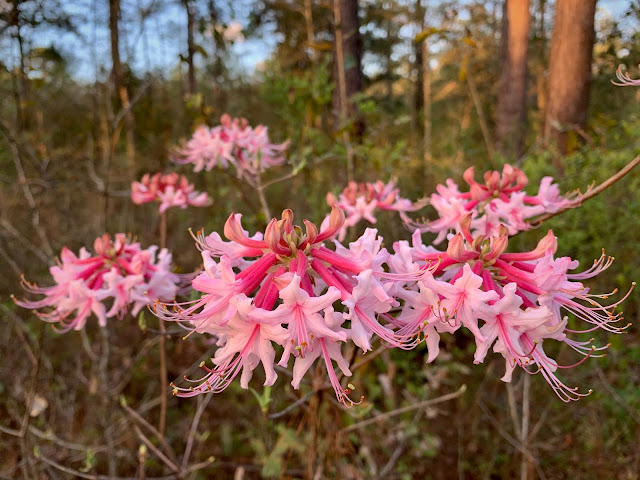Pokeweed: a bird-friendly native
Pokeweed (Phytolacca americana) has a wide distribution from eastern Canada, down through all of Florida, across the southern states, and up the west coast to Washington State. They favor sandy disturbed soils. Poke weed plants have grown very well atop the drainfield mound on our property. The official descriptions of this plant peg the height as up to 10 feet. I guess "they" didn't consider our long growing season here in Florida or that they might lean on tree branches for support. Pokeweed continues to grow, bloom, and produce its dark purple berries right until the first killing frost when it dies back, but the root survives and sends up new shoots in the spring. Each year the plant gets larger and some of ours have reached more than 20-feet tall when they can lean on something for support. The stems are weak because of the mostly hollow pith and without support, the plant breaks when it gets too heavy with berries.
I've seen various species of birds eating the berries, and purple deposits polka dot the cement driveway under trees where those birds perch near this plant. It's a desirable weed for your wildlife garden, but the roots had become too large and threatened the integrity of the pipes that are about ten inches deep in the soil. So I removed a bunch from the top of the drainfield, but there are more growing in other wild or semi- wild areas in our yard.
I've done my share of foraging over the years, but I've never been tempted by pokeweed, because you need to catch it early in the season before the poisons build up in the stem when you can cut it off and eat it like asparagus. You also can eat the greens, but you must boil them twice and throw out the first water to get rid of the toxins--this has been called poke sallet, an old English term for cooked greens. I always thought people were saying, "poke salad," but that didn't make any sense because you'd never eat the uncooked greens. The root and the seeds are the most toxic parts of the plant.
Native Americans took full advantage of pokeweed, using the plant medicinally and employing the berries and stems for dye and for painting their horses. Supporters for James Polk, our eleventh president, reportedly wore pokeweed leaves around their necks. The common name is sometimes spelled, "Polk."
So let some of your property go wild and you might grow your very own poke weed forest for the birds.
For more information and photos of pokeweed, see its profile on:
Atlas of Florida Vascular Plants and the USDA website.
The catbriar roots usually have a peppery odor and were the source for root beer and sasparilla. Maybe they still are...
Ginny Stibolt
 |
| Purple poke berries feed lots of birds. |
 |
| The poke roots get larger each year even though the top dies back. They look sorta like giant sweet potatoes, but the fuchsia sprouts let you know it's a poke root. |
I've done my share of foraging over the years, but I've never been tempted by pokeweed, because you need to catch it early in the season before the poisons build up in the stem when you can cut it off and eat it like asparagus. You also can eat the greens, but you must boil them twice and throw out the first water to get rid of the toxins--this has been called poke sallet, an old English term for cooked greens. I always thought people were saying, "poke salad," but that didn't make any sense because you'd never eat the uncooked greens. The root and the seeds are the most toxic parts of the plant.
Native Americans took full advantage of pokeweed, using the plant medicinally and employing the berries and stems for dye and for painting their horses. Supporters for James Polk, our eleventh president, reportedly wore pokeweed leaves around their necks. The common name is sometimes spelled, "Polk."
So let some of your property go wild and you might grow your very own poke weed forest for the birds.
For more information and photos of pokeweed, see its profile on:
Atlas of Florida Vascular Plants and the USDA website.
 |
| Catbriar roots can also get surprisingly large, but they are whiter and knobbier than the pokeweed roots. |
For those who thought that these roots were catbriar (Smilax spp) tubers, here's what those roots look like. >>
The catbriar roots usually have a peppery odor and were the source for root beer and sasparilla. Maybe they still are...
Ginny Stibolt



Comments
Changing the water does not delete the nutritional value of Pokeweed, it just removes the toxins, it is in fact extremely nutritious as well as medicinal. Wondering are the the same "Grower Jim" affiliated with Homegrown Local Food Co-op in Winter Park?